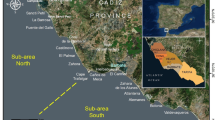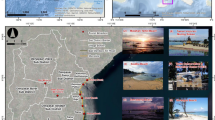Abstract
With the rapid expansion of the scale of deep sea net-cage use in the nearshore area of Hainan Island, tropical cyclone-induced wave hazard assessment is urgently needed. In this study, the wind-wave-current coupled ADCIRC + SWAN model, which considers the effects of tidal and storm surges, was used to simulate tropical cyclone events over the last 33 years. This model adopts an unstructured high-resolution grid with a nearshore resolution of up to 100 m. The compared simulated results and observations during typhoons JEBI (2013), HAIYAN (2013) and KALMAEGI (2014) were in agreement. This study statistically analyzed maximum significant wave heights on the basis of a large set of simulated storm wave level maps to derive the wave heights of different return periods. Then, the results of nearshore wave hazard classification were obtained by applying the affinity propagation (AP) clustering method to dozens of nearshore profiles. The results demonstrate that the risk at any point in the nearshore area of Hainan Island is dominated by the wave hazard type and water depth condition. The wave hazard assessment method developed for Hainan Island will be significant in assisting government decision-making in the rational planning of deep sea net-cage aquaculture.













Similar content being viewed by others
References
Albert J, Sahoo B, Bhaskaran PK (2021) Tropical cyclogenesis identification using eddy detection technique for the Bay of Bengal Basin - ScienceDirect. Atmos Res 260:105670
Booij N, Ris RC, Holthuijsen LH (1999) A third-generation wave model for coastal regions: 1. Model description and validation. J Geophys Res Oceans 104(C4):7649–7666
Dietrich JC, Bunya S, Westerink JJ, Ebersole BA, Smith JM, Atkinson JH, Jensen R, Resio DT, Luettich RA, Dawson C, Cardone VJ, Cox AT, Powell MD, Westerink HJ, Roberts HJ (2010) A high-resolution coupled riverine flow, tide, wind, wind wave, and storm surge model for southern Louisiana and Mississippi. Part II: synoptic description and analyses of Hurricanes Katrina and Rita. Monthly Weather Rev 138(2):378–404
Dietrich JC, Zijlema M, Westerink JJ, Holthuijsen LH, Dawson C, Luettich RA, Jensen RE, Smith JM, Stelling GS, Stone GW (2011a) Modeling hurricane waves and storm surge using integrally-coupled scalable computations. Coast Eng 58(1):45–65
Dietrich JC, Westerink JJ, Kennedy AB, Smith JM, Jensen RE, Zijlema M, Holthuijsen LH, Dawson C, Luettich RA, Powell MD, Cardone VJ, Cox AT, Stone GW, Pourtaheri H, Hope ME, Tanaka S, Westerink LG, Westerink HJ, Cobell Z (2011b) Hurricane Gustav (2008) waves and storm surge: hindcast, synoptic analysis, and validation in Southern Louisiana. Mon Weather Rev 139(8):2488–2522
Egbert GD, Erofeeva SY (2002) Efficient Inverse modeling of barotropic ocean tides. J Atmos Oceanic Tech 19(2):183–204
Frey BJ, Dueck D (2007) Clustering by passing messages between data points. Science 315(5814):972–976
Gao J, Luettich RA, Fleming JG (2013) Development and initial evaluation of a generalized asymmetric tropical cyclone vortex model in ADCIRC. In Proceedings of the 17th ADCIRC Users Group Meeting, Vicksburg, MS, USA
GEBCO Bathymetric Compilation Group 2019 (2019) The GEBCO_2019 Grid— a continuous terrain model of the global oceans and land. British Oceanographic Data Centre, National Oceanography Centre, NERC, UK
Holland GJ (1980) An analytic model of the wind and pressure profiles in hurricanes. Mon Weather Rev 108(8):1212–1218
Hope ME, Westerink JJ, Kennedy AB, Kerr PC, Dietrich JC, Dawson C, Bender CJ, Smith JM, Jensen RE, Zijlema M, Holthuijsen LH, Luettich RA, Powell MD, Cardone VJ, Cox AT, Pourtaheri H, Roberts HJ, Atkinson JH, Tanaka S, Westerink HJ, Westerink LG (2013) Hindcast and validation of Hurricane Ike (2008): waves, forerunner, and storm surge. J Geophys Res Oceans 118(9):4424–4460
Horn M, Walsh K, Zhao M, Camargo SJ, Scoccimarro E, Murakami H, Wang H, Ballinger A, Kumar A, Shaevitz DA, Jonas JA, Oouchi K (2014) Tracking scheme dependence of simulated tropical cyclone response to idealized climate simulations. J Climate 27(24):9197–9213
Krien Y, Dudon B, Roger J, Zahibo N (2015) Probabilistic hurricane-induced storm surge hazard assessment in Guadeloupe, Lesser Antilles. Nat Hazard 3(1):401–427
Le TA, Takagi H, Heidarzadeh M, Takata Y, Takahashi A (2019) Field surveys and numerical simulation of the 2018 Typhoon Jebi: impact of high waves and storm surge in semi-enclosed Osaka Bay, Japan. Pure Appl Geophys 176(10):4139–4160
Luettich RA, Westerink JJ (2004) Formulation and numerical implementation of the 2D/3D ADCIRC finite element model version 44
Mattocks C, Forbes C, Ran L (2006) Design and implementation of a real-time storm surge and flood forecasting capability for the State of North Carolina. UNC-CEP Technical Report 30
Mattocks C, Forbes C (2008) A real-time, event-triggered storm surge forecasting system for the state of North Carolina. Ocean Model 25(3):95–119
Mondal M, Haldar S, Biswas A, Mandal S, Bhattacharya S, Paul S (2021) Modeling cyclone-induced multi-hazard risk assessment using analytical hierarchical processing and GIS for coastal West Bengal, India. Regional Stud Marine Sci 44:101779
Mondal M, Paul S, Bhattacharya S, Biswas A (2020) Micro-level assessment of rural societal vulnerability of coastal regions: an insight into Sagar Island, West Bengal, India. Asia-Pacific J Rural Dev 30(1–2):55–88
Montgomery MT, Enagonio J (1998) Tropical cyclogenesis via convectively forced vortex Rossby waves in a three-dimensional quasigeostrophic model. J Atmos Sci 55(20):3176–3207
Musinguzi A, Akbar MK, Fleming JG, Hargrove SK (2019) Understanding hurricane storm surge generation and propagation using a forecasting model, forecast advisories and best track in a wind model, and observed data-case study hurricane rita. J Marine Sci Eng 7(3):77
Pandey S, Rao AD (2018) An improved cyclonic wind distribution for computation of storm surges. Nat Hazards 92(1):93–112
Powell MD, Vickery PJ, Reinhold TA (2003) Reduced drag coefficient for high wind speeds in tropical cyclones. Nature 422(6929):279
Powell MD (2007) New findings on hurricane intensity, wind field extent, and surface drag coefficient behavior. Tenth international workshop on wave hindcasting and forecasting and coastal hazard symposium, North Shore, Oahu, Hawaii
Raavi PH, Walsh KJE (2020) Sensitivity of tropical cyclone formation to resolution-dependent and independent tracking schemes in high-resolution climate model simulations. Earth Space Sci 7(3):e2019EA000906
Ris RC, Booij N, Holthuijsen LH (1999) A third-generation wave model for coastal regions, 2. verification. J Geophys Res 104(C4):7667–7681
Sahoo B, Bhaskaran PK (2016) Assessment on historical cyclone tracks in the Bay of Bengal, east coast of India. Int J Climatol 36(1):95–109
Shoemaker DN, Gray WM, Sheaffer JD (2009) Influence of synoptic track aircraft reconnaissance on JTWC tropical cyclone forecast errors. Weather Forecast 5(3):503–507
Xie L, Bao S, Pietrafesa LJ, Foley K, Fuentes M (2006) A real-time hurricane surface wind forecasting model: formulation and verification. Mon Weather Rev 134(5):1355–1370
Xu L, Wang A, Wang D, Wang H (2018) Hot spots of climate extremes in the future. J Geophys Res Atmos 124(6):3035–3049
Yin C, Huang H, Wang D, Liu Y, Guo Z (2020) The characteristics of storm wave behavior and its effect on cage culture using the ADCIRC+SWAN model in houshui bay, china. J Ocean Univ China 19(02):63–75
Acknowledgements
This work was supported by the National Natural Science Foundation of China (NSFC)-Shandong Joint Fund for Marine Science Research Centers (No. U1606401), the NSFC Fund (No. 41976166), the Hainan Provincial Natural Science Foundation of China (420QN367), and the Technology Development Foundation for Research Institutes of Hainan Province (Priority Support Plan). We would like to thank SCSBSOA for providing hydrological datasets. Many thanks also to the anonymous reviewers for offering advice on the manuscript.
Funding
The authors have not disclosed any funding.
Author information
Authors and Affiliations
Corresponding authors
Ethics declarations
Competing interests
The authors declared that they have no conflicts of interest to this work.
Additional information
Publisher's Note
Springer Nature remains neutral with regard to jurisdictional claims in published maps and institutional affiliations.
Rights and permissions
About this article
Cite this article
Yin, C., Huang, H., Wang, D. et al. Tropical cyclone-induced wave hazard assessment in Hainan Island, China. Nat Hazards 113, 103–123 (2022). https://doi.org/10.1007/s11069-022-05266-2
Received:
Accepted:
Published:
Issue Date:
DOI: https://doi.org/10.1007/s11069-022-05266-2




